How to Get Rid of Gnats: Dealing with gnats in your home can feel like a full-on war—I’ve dealt with infestations that seemed to come out of every cranny. It all started with some overripe fruits I’d left out near my counter. Before I knew it, thousands of tiny bugs were hovering near the sink, in my potted plants, and even near the toilet. What worked for me? A mixture of vinegar, soda, and a bit of beer in plastic bowls. I let the trap sit overnight and by the next day, I saw amazing results. For extra punch, I ordered sticky traps from Amazon and set them near every suspected source—especially houseplants and drains where eggs might hatch.
Also i got serious about keeping things cleaned—especially my dishes, the fridge, and trash bins. I poured hot water and soda down every drain and scrubbed away all the gunk. Even i tried zappers—not always the most effective on gnats, but helpful when larger flying bugs joined the fight. I learned the hard way that adulting means checking every box, every face cloth, even the kitty‘s area, because bugs will find any warm, moist spot to breed.
Now i keep peels out of the open, use bioactive soil when I plant, and give my plants proper care. It may sound nuclear, but sometimes you just have to nuke the problem multiple times a week. If you’re on a budget, many of these solutions are cheap, DIY, and surprisingly harmless to use around pets—yes, even cats. It’s all about knowing what’s lurking, acting fast, and treating your home like a parent would a sick child—with a wallet full of suggestions and a head full of determination.
What Are Gnats?
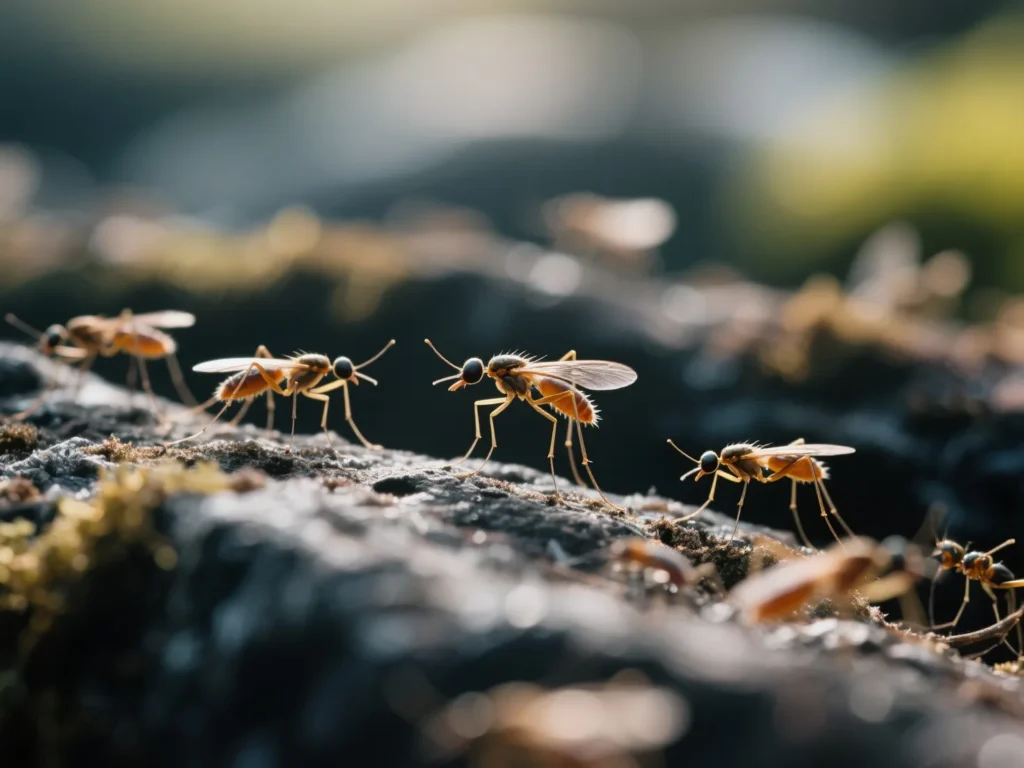
In the heat of summer, my home became a battleground. I battled these tiny, flying bugs every day—especially near drains, trash, and overripe fruits. I didn’t just find them in the kitchen—I saw them in my garden, around planters, and even hovering near my houseplants. These obnoxious, common insects love moisture, especially where there’s decaying or rotting material like vegetables or food. I found them hovering around my bins, garbage, and even septic and drain areas that seemed clean on the surface. Gnats come in different types—not just one. Some have brown or black bodies, furry heads, and wings that hover so persistently they turn into a full-time distraction.
I finally figured out that many come from stagnant water, wet soil, or places like tanks, sewers, and drains, where eggs rapidly breed. Gnats especially seek out alcohol, overripe fruit, and anything smelly or decaying—whether it’s on the counter or hanging in planters, they’ll find it. I noticed hovering clouds near bottles left out, drains, and even silver kitchen bins. Some resemble a moth and others are just flies with no chill. To eliminate them, it’s important to know what type you’re dealing with and what attracts them.
Whether you’re a garden lover or just someone trying to rid their home of a nuisance, gnats demand efficient, effective action. From shaking off your houseplant pots to scrubbing drains, it helps to be proactive and consistent. I always suggest starting with knowing the name and habitat of the pest—because once you do, the path to elimination becomes a lot more manageable.
12 Ways to Get Rid of Gnats
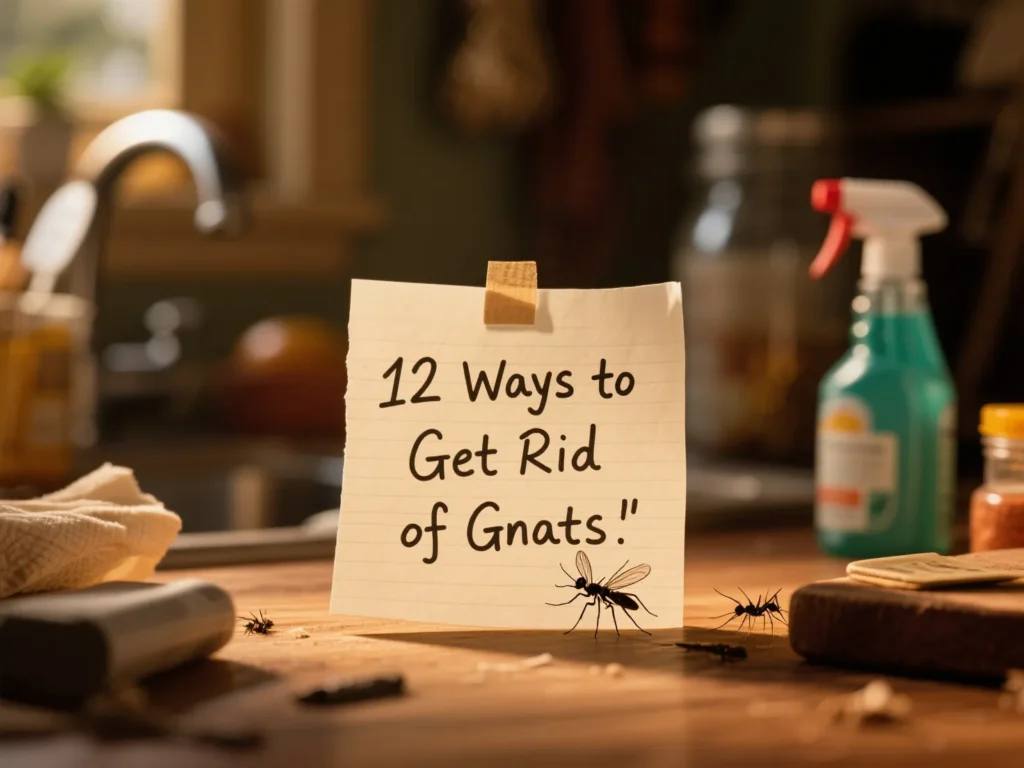
To get rid of gnats for good, you need to target both where they lay eggs and how they come into your home. Start by cleaning your sink, garbage, and trash containers regularly, and throw out any overripe produce or food. Keep your plants on a dry cycle by spacing out waterings, as fungus gnats thrive in moist soil. I always recommend sprinkling a thin layer of diatomaceous earth on top of your houseplants’ soil to kill larvae. Don’t forget to patch any cracks or crevices, especially between tiles or around windows, doors, and screens—gnats are likely slipping in through those gaps.
If you’re serious, invest in better seal options or use a silicone sealer. Tightly close containers and properly store fruits like apples to prevent re-infestation. If you’ve found gnats near your disposal, run a cleaner through it and scrub down the zone. People often miss these tricky areas, but once repaired and sealed, you’ll stop gnats from coming back again.
1- Lure Them With Ripe Produce
One of the simplest traps I’ve made when dealing with gnats is using their favorite thing—fruit. Just take an overripe banana, apple, or any soft produce, mash it slightly, and place it in a small bowl. Then, cover the top with plastic wrap and poke tiny holes in it. The flies will crawl inside, drawn to the sweet snack, but they won’t find their way back out. I use this method often and keep it in areas where gnats tend to place themselves, like near the fruit basket or the sink. It’s super easy and incredibly effective when you’re trying to cut down on their numbers fast.
2- Put Empty Wine Bottles to Good Use
The smell of alcohol naturally attracts gnats, making old wine bottles the perfect DIY trap. Just leave a bit of the red wine dregs inside, add a few drops of dish soap, and place the bottle on the counter where you’ve seen activity. The scent draws them in, and the soap breaks the surface tension, so they can’t crawl back out. I’ve seen people surprised at how well this trick works—especially for those who don’t want to buy new traps. If you use what you already have, it’s a clever way to handle gnats without extra expense or effort.
3- Flush Drains with Bleach
To kill hidden eggs and fruit flies nesting in your drain, I always mix ½ cup of bleach with a gallon of hot water to create a diluted solution. Carefully pour it down the pipes, making sure to flush slowly so it reaches deep. If necessary, repeat the process the next night for stubborn infestations. This method helps sanitize the drain and prevents further hatching, especially in areas where gnat activity is common.
4- Hydrogen Peroxide To Get Rid Of Gnats:
When I faced a gnat infestation in my potted plants, I found hydrogen peroxide to be an incredibly effective, natural remedy. Simply mix one part 3% hydrogen peroxide with four parts water in a spray bottle, then apply it to the affected soil in the garden or indoor plants. This solution releases oxygen on contact, which suffocates the larvae hiding in moist, waterlogged soil. It’s important to first identify the source of the breeding area. Usually near congregation zones like overwatered pots, and treat them thoroughly. I repeat the process every week until I completely eliminate the gnats. And make sure not to exceed the concentration to avoid damage to the environment or plant roots. It’s a safe and smart method that keeps both your plants and peace of mind intact.
5- Pheromone Traps For Gnats:
Pheromone traps are a smart strategy for gnats when you’re looking for targeted pest control, especially during active mating periods. These sticky traps work by attracting male gnats using a scent that mimics the female, specifically interrupting the reproductive cycle. I always set them in dirty or high-moisture zones, where fungus gnats tend to gather. And follow the instructions for placing them close to surface layers of soil or near active activity spots.
They come in a range of sizes and shapes. And can be a standalone solution or part of an integrated management plan. Be sure to replace them regularly to get full results. And match the trap to the type or species you’re dealing with. For larger infestations, pairing them with other methods gives even better outcomes and acts as a protective layer for your treatment area.
6- Vacuum Traps For Gnat:
Vacuum traps are a highly effective way to capture gnats in both indoor and outdoor homes or gardens. Especially when you’re looking for non-chemical control. These traps are designed to suck gnats in using powerful suction. And many come in various shapes and sizes to fit different settings. I’ve used both rechargeable and plugged versions—some with batteries. Others that run on an electrical outlet—and both worked great. The principle is simple: gnats are drawn toward the trap’s light or airflow, then pulled in and held. This not only helps prevent them from reproducing, but also quickly reduces their populations. For best results, place them near breeding sources and choose a unit with enough power for your space, whether commercial or residential use.
7- Essential Oils That Get Rid Of Gnats:
Essential oils are a natural, safe way to repel gnats indoors, especially around children and pets. I like to mix about 10 to 15 drops of gnat-repelling oils like citronella, eucalyptus, or peppermint in a spray bottle with water and lightly mist common problem areas. These work well as bug repellents, and can also be used in diffusers to keep the scent present in the air. However, I always advise caution—some people can have allergic reactions or skin irritation, so avoid contact with the face and be careful when applying or handling near sensitive zones. When applied properly and with care, these oils can help keep your space gnat-free without harsh chemicals.
Best sticky traps for kitchen Gnats
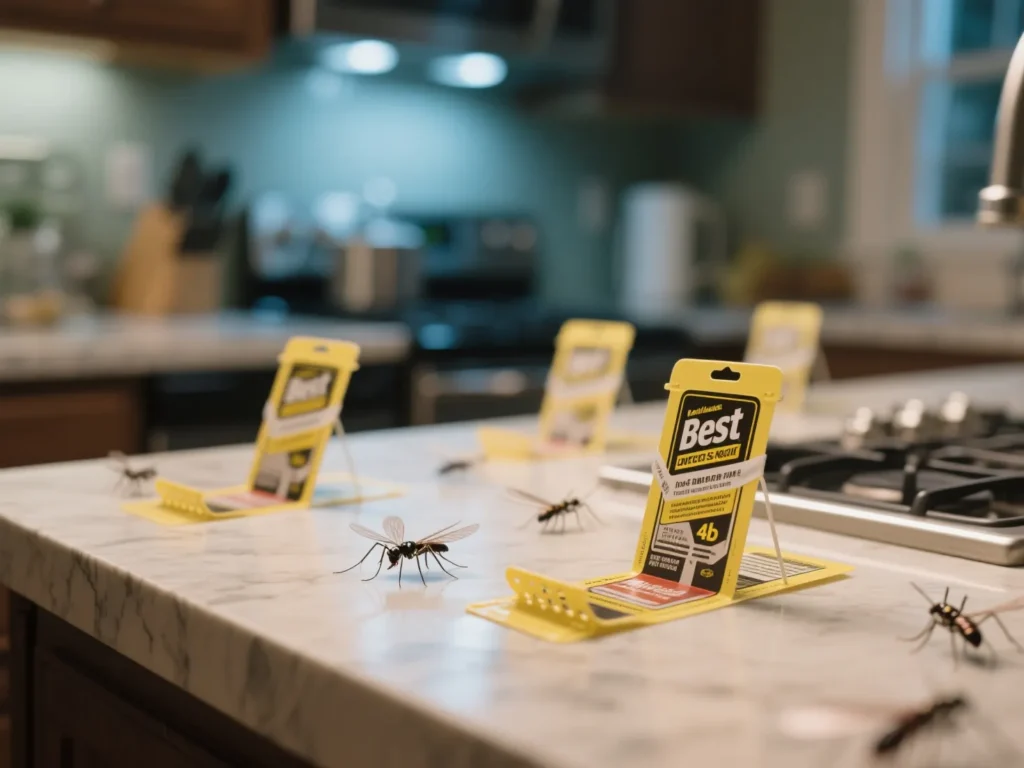
When it comes to dealing with kitchen gnats, choosing the right sticky traps is crucial to capture as many flying bugs as possible and stop them from breeding near your sink, trash, or fruits. I always select yellow or blue traps, as those colors are best for attracting fungus gnats and fruit flies. These traps come in a range of sizes and shapes. From classic sticker sheets to small pots you can stick in your soil or plants. For maximum effectiveness, I place them in strategic locations—near compost bins, cans, and dirty surfaces—where dozens of gnats tend to congregate. Make sure to monitor them regularly and replace once they’re visibly stuck with insects, dust, or debris.
It’s essential to keep traps clean and change them out every few days to keep the capture rate high. I’ve found that putting a new trap near breeding areas like plants, sink drains, or near rotting fruits works as an effective method to break the life cycle. Sticky traps are a bad place for tiny pests to hide—once they land, they’re stuck for good. This not only gives you peace of mind but also helps you snatch adult insects before they lay more eggs. Whether you’re grossed out or just trying to rid your space of a constant nuisance. These traps offer one of the most reliable steps toward preventing further infestations and keeping your kitchen fresh and clean.
8- Yellow gnat traps
Yellow gnat traps are a classic solution that really work—the color itself attracts gnats within seconds. I like to nestle these traps right into the soil of potted plants where gnats often sit or build their nests. They’re affordable in price, easy to leave in place, and deliver great results without any mess. If you’re looking to be able to handle a gnat issue quickly and effectively, yellow traps are a simple go-to.
9- Light traps
I’ve tried several types of light traps. And the blue ones seem to work best for attracting flying insects, especially gnats. The reason they’re so effective is that gnats are drawn to the light. Then get stuck on the sticky sheets or adhesive surface inside the traps. As an addition to other methods, like soil treatments or fruit removal. These traps are one of the best tools to keep near kitchen counters or plant stands where gnats gather.
10- Cuter traps
If you’re tired of ugly bug traps ruining the aesthetic of your kitchen. There are now cuter options that blend in beautifully. Some traps come in sleek, ceramic designs or minimalist shapes that aren’t obvious at all but still resistant and effective. I’ve even found options shaped like little mushrooms or apples that look like décor while quietly doing their job.
11- Terro Fruit Fly Trap
The Terro Fruit Fly Trap is a cute, pre-filled trap that actually works—I’ve used it in my sink area, near garbage, and even around plants where gnats and fruit flies tend to congregate. The container is shaped like an apple, and inside is a non-toxic liquid made with a fruity vinegar and cider mixture, often combined with drops of dish soap to prevent flies from escaping. You can also make your own version by filling a shallow cup or jar with a solution of vinegar, soap, and apple cider—just poke a few holes in plastic wrap on top.
Whether you’re buying the official Terro trap or going DIY, these methods are safe around children and pets. And very effective in eliminating small infestations in just a few days. I check mine daily and change out the vial or homemade version every few days for best results. It’s one of those rare traps that balances cute executions with real bug-killing power.
12- We The Wild Sticky Trap
The We The Wild Sticky Trap is a strong. Neon yellow trap designed to snatch gnats and fungus bug pests straight from your soil. I’ve used these sticky traps around each plant, and they really work—the adhesive is tough.Aand the surface collects the tiny corpses in no time. This brand makes attractive. Minimal shapes that blend well with greenery and can be placed directly in the soil or even hung if needed. It’s a smart solution that turns pest control into something stylish, not gross.
Identify The Source Of The Gnat Infestation
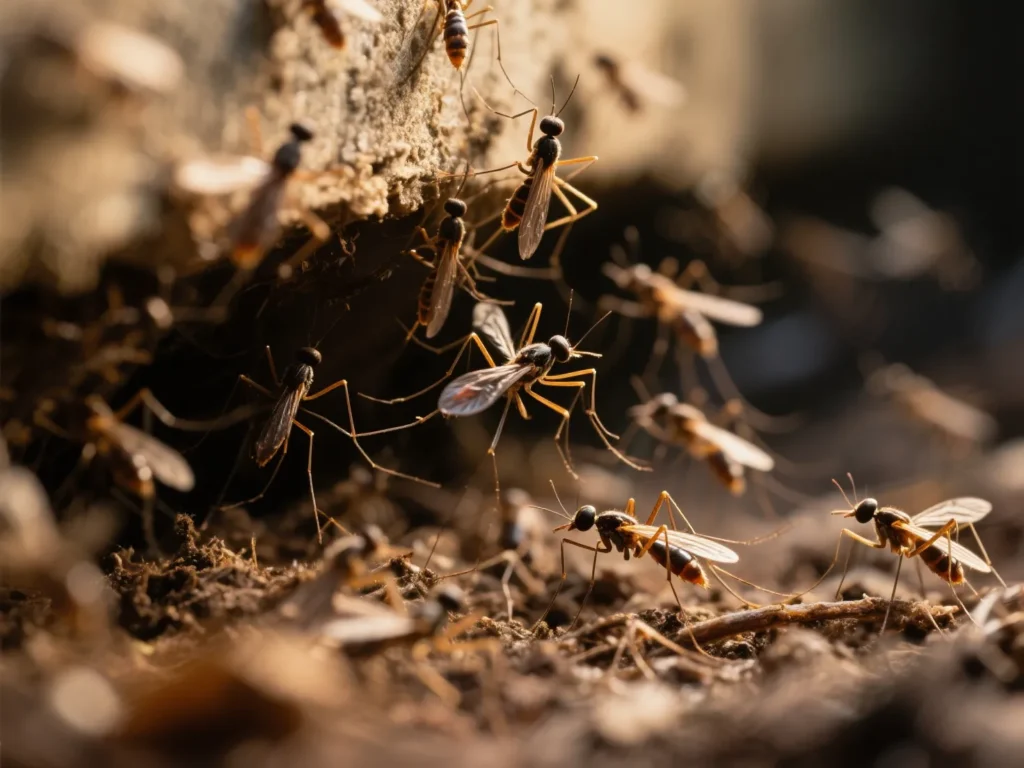
To get rid of those pesky gnats, the first and most important step is to identify the source of the infestation. These tiny insects often hide near plants, sink drains, or rotting fruit, so inspecting these areas closely can really help. Once you know where they’re coming from, the next steps in your seven-step plan to control and eliminate them become much more effective.
Look for Breeding Sites:
When trying to rid your space of gnats, always look for their breeding spots—these tiny pests are attracted to any kind of dampness or decaying matter. Check flower pots, houseplants, compost, trash cans, and even standing water in sinks, bird baths, or clogged gutters. In the kitchen, it’s common to find them near collecting moisture or hidden piles of organic debris. Make sure your soil is kept dry between waterings and empty anything that may be collecting water—this simple step cuts down on their numbers fast.
Check for Overripe Fruits and Vegetables:
To prevent gnats from taking over your kitchen. Always check for overripe or rotting fruits and vegetables—they’re a prime target for these pests. Gnats are highly attracted to the fermenting smell, making them hard to ignore once they arrive. Be sure to store produce properly, ideally in the refrigerator. And discard anything that looks like it’s attracting bugs to stop the problem before it starts.
Inspect Your Houseplants:
If you suspect a gnat infestation, be sure to inspect your houseplants carefully, especially the soil. Gnats often lay eggs near the surface, and you might notice tiny flying insects or white larvae wriggling in the dirt—both are clear signs of trouble. To treat the affected plants, remove the top layer of soil and replace it with fresh, dry soil. For deeper treatment, I like to drench the pot with a solution containing beneficial nematodes, which safely kill the larvae and eggs without harming your plant. This method has saved several of my houseplants from total ruin.
Check Your Drains:
Drains are a hidden hotspot where gnats love to breed, especially in sinks, bathtubs, and shower drains. If you see tiny flying insects or black specks near the drain, those are likely signs of an early infestation. I’ve found a simple mixture of baking soda and vinegar helps clean the pipes and remove the organic matter that’s attracting them. Follow it with hot water or a drain cleaner to fully flush things out and break their cycle. Keeping drains gnat-free is one of the easiest ways to stop them before they take over.
Look for Moisture:
Gnats are heavily attracted to moisture, so keeping your home dry is key to keeping them away. I always look for leaky faucets, poorly functioning pipes, or air conditioning units that leave behind excess water. Using a dehumidifier can help reduce moisture levels in humid areas, making it less inviting for gnats to settle in. Fix any problem spots quickly to stop them from turning into a breeding ground.
Inspect Your Garbage:
To stop gnats from attracting to your garbage. It’s important to inspect your cans regularly and remove any organic food scraps or matter that may be lingering. I make it a habit to empty and rinse my bins with a vinegar mixture and hot water every few days—this keeps the area clean and less appealing to bugs. Even a little residue can become a gnat hotspot if left unchecked.
Check Your Pet’s Food and Water Bowls:
Gnats are often attracted to your pet’s food and water bowls, especially if they’re not cleaned regularly. I always remove leftovers and wipe down the area to keep bugs away. Using a pet-safe repellent around the feeding zone can help too, just make sure it’s safe for pets. A little upkeep goes a long way in keeping gnats from turning your furry friend’s dinner spot into a bug party.
How to Avoid Household Gnats
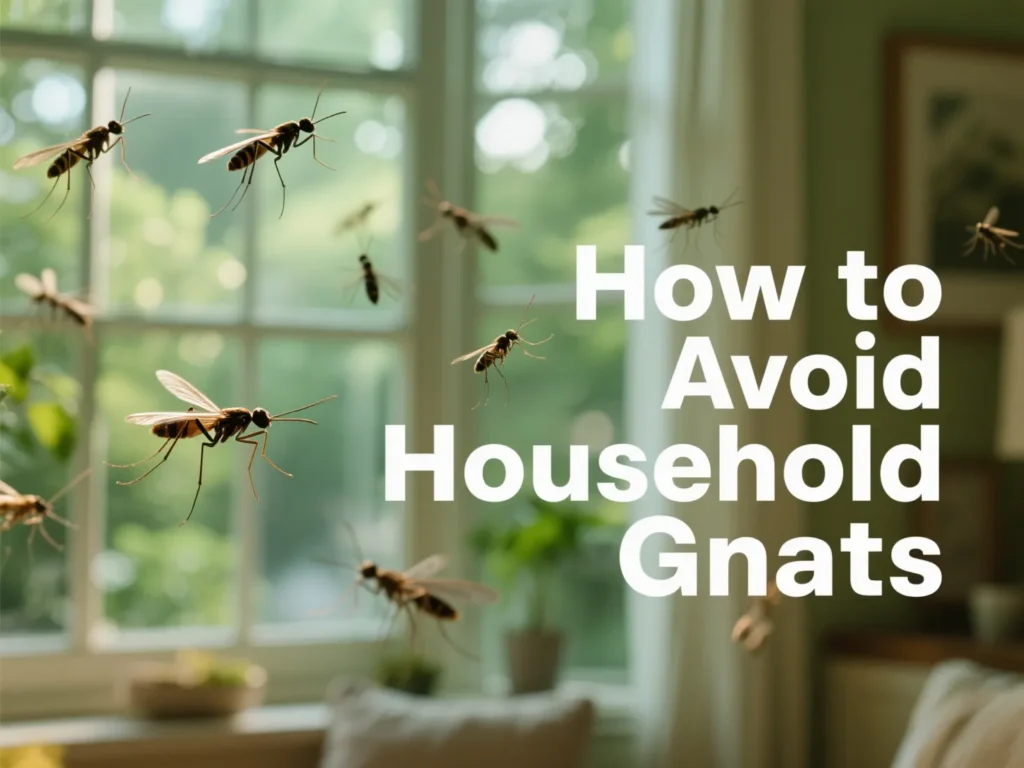
To avoid a gnat problem in your home, it’s smart to stay one step ahead with solid prevention protocols. Start by keeping fruit and plant soil clean and dry—fungus gnats multiply in moisture and lay eggs near the roots. Where larvae eat decaying material. Don’t let food or moisture accumulate, and always remove overripe produce before flies appear. I’ve learned the hard way that a single oversight can lead to the worst infestation. A good tip is to improve air circulation and target adult gnats quickly before they lay more eggs. These irritating pests spread faster than you think, so staying on top of daily habits keeps your house gnat-free. With the right solutions and a bit of daily care, you’ll turn their favorite home into their worst enemy.
1. Avoid overwatering plants
To prevent gnats from invading your plants, it’s crucial not to overwater. I always check that the top inch of soil feels dry before the next watering, and I make sure my pots have proper drain holes so excess water doesn’t stay gathered at the bottom. Damp, saturated soil is like an open invite for fungus gnat growth, as they’re especially attracted to moist environments. I sometimes sprinkle a bit of cinnamon on the surface—it acts as a natural treatment. Using a catcher tray under plant pots, or even brewing mosquito tea as a deterrent, helps too. And don’t forget to wipe down the pot and dish regularly; clean surroundings are a simple but powerful way to prevent infestations.
2. Clean up food residue
To keep bugs like gnats away, it’s essential to clean up food residue from your counters, sink, stove, and even drains regularly. After lunch or dinner, I make sure every surface is wiped down thoroughly, especially in those small spaces where crumbs or grease hide. Leftover bits become perfect breeding grounds for gnats, especially near disposals. Staying on top of this simple routine can prevent a full-blown invasion.
3. Drain standing water
To prevent bugs like gnats from showing up, never leave standing water lying around—especially in dishes, soaking pans, or trays left out overnight. These moist spots are perfect for pests to lay their eggs, and gnats are especially attracted to them. I make it a daily habit to empty and dry anything that doesn’t need to stay hydrated, keeping my kitchen free from unwanted pests.
4. Rinse banana stems
To avoid fruit flies from invading your home, always rinse the stems of your banana bunch as soon as you bring them in. These pests often lay their eggs right where the fruit connects at the top, and from there, they can invade your space. A quick wash helps stop the problem at the peel, and in many cases, prevents an infestation altogether.
5. Take out garbage regularly
Taking out the trash regularly is one of the simplest ways to keep pests and insects away from your trashcan. I always remove meat scraps, old treats, and other grody leftovers before they start to smell yummy to bugs. To stay ahead, I dispose of waste appropriately and as often as needed—especially after cooking—so nothing lingers long enough to attract unwanted visitors.
How to dispose of meat without attracting bugs:
- Freeze scraps – After cooking, place leftover meat, broth, or oily bits into a sealed container or bag and store it in the freezer until trash day. This prevents smells that attract bugs.
- Use sealed bins – Always dispose of meat in a tightly sealed indoor trash bin, or better, directly in your outside garbage to keep bugs from invading your kitchen.
- Never compost meat – Avoid adding meat scraps to regular compost piles, as they can attract pests and even larger animals like dogs or pigs if not managed properly.
- Take trash out often – Don’t let meat sit in your garbage for long. Take it outside as soon as possible, especially in warm weather.
- Use as animal feed (if safe) – In some households, cooked meat scraps can be carefully given to dogs or pigs as feed, but always ensure it’s safe and doesn’t contain bones or seasonings harmful to animals.
- Clean up oil and residue – If you’ve poured oil or broth down the sink, follow with soap and hot water to avoid attracting bugs around your drains.
6. Act fast
To avoid a full-blown gnat infestation, it’s important to act fast—as soon as you spot even one. Dozens can appear within days if left untreated, turning a small issue into a major headache. I always jump into treatment as early as possible, because that quick response makes all the difference in how many you’ll end up dealing with.
Fungus gnats vs Fruit flies
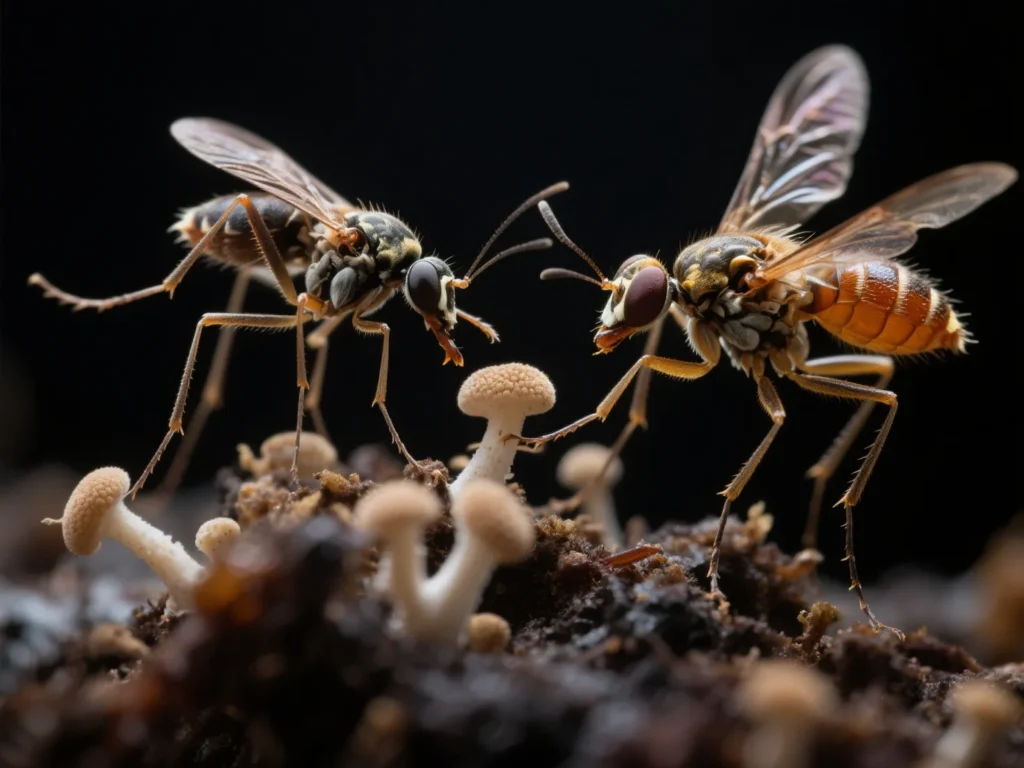
Though fungus gnats and fruit flies may seem similar, knowing how to determine the difference helps you target them in the right ways. Fruit flies are more common around overripe fruit, the trashcan, and anything sugary—they’re larger, more like a tiny housefly, and absolutely love sugar. Fungus gnats, on the other hand, are smaller, behave more like mosquitoes, and usually hover near houseplants, sink drains, or areas with damp soil. These little bugs are attracted to gnats’ favorite breeding grounds—moist pots, water buildup, or decaying roots—while fruit flies thrive on the surface of sweet, fermenting food. Each has its own unique triggers, so the best solution is treating the exact spots they appear in your home.
The important difference:
The most important distinction between fruit flies and fungus gnats lies in what they’re attracted to—fruit flies are drawn to the sweetness of overripe produce, while fungus gnats prefer damp soil and decaying plant matter. This difference dictates the steps you should take to get rid of them. If your home has a gnat issue near plants, focus on drying out the soil and treating for fungus. For flies near the kitchen, it’s all about cleaning and removing sugary lures.
Conclusion:
Gnats infestations, a home battleground, tiny bugs drawn to moisture, decaying material, overripe fruits, plants, drains. Effective action involves traps (vinegar, soda, beer, sticky, pheromone, vacuum, light, Terro, We The Wild), cleaning (sink, garbage, trash, dishes, fridge), hot water, soda, bleach, hydrogen peroxide, essential oils, yellow traps. Identify breeding sites for prevention and elimination. Be proactive, consistent, and safe for pets, children. Solutions require a wallet full of suggestions and a head full of determination for a manageable outcome. Read More at Insight Web
FAQ’s
The fastest method to stop fruit flies is to target their egg-laying spots and apply a mix of traps and cleaning tricks. Fix damp areas, scrub sink drains, and discard spoiled sweet produce. DIY traps with banana peels and wrap, or store-bought bait traps, can reduce flying pests.
Gnats are drawn to and reproduce in spots with dampness and rotting organic waste. Usual sources include soggy potted soil, leftover food messes, open trash bins, and blocked pipes. They can also get inside your house via open windows or gaps and might hitch a ride on groceries or fresh plants.
Gnats dislike powerful, sweet, or spicy smells from specific herbs and oils. Scents like peppermint, citronella, eucalyptus, lavender, vanilla, and citrus naturally drive them away. Even household smells such as vinegar, cinnamon, or cooking oils can keep gnats at bay.
Yes, white vinegar can be used to make gnat traps. Though apple cider vinegar is often preferred for its sweeter smell that draws gnats in more easily, white vinegar still works as an effective alternative when that’s what you have on hand.

